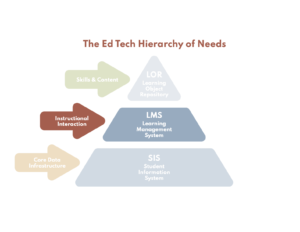From LMS to Learning Ecosystems

EdWeek’s Ian Quillen reviewed a Don McIntosh report on the learning management systems (LMS) market. “It’s getting to be such a huge list that it’s beginning to lose its usefulness,” laments McIntosh. Ian notes that many observers believe the sector is “becoming one in which new entrants have real opportunities to leap ahead of established players.”
In fact, the market is even more dynamic than the McIntosh report suggests because the scope is limited to the roles fulfilled by traditional LMS but the market has changed dramatically in the last three years–consider adaptive content, social learning, comprehensive profiles, smart engines, lots of open content, and an explosion of mobile apps.
“If you look at all those needs and increased customization that comes with it, that is more than what has been in the traditional LMS,” says Matthew Wicks, the chief operating officer for the Vienna, Va.-based International Association for K-12 Online Learning, or iNACOL, and a former online learning consultant. “I haven’t seen any one vendor emerge as far as putting all of those pieces together.”
The sector is in the early stages of transitioning from LMS to learning platform ecosystems. As noted in the 10 Elements of the Post Textbook World content libraries will exist within ecosystems will include these elements:
- Standards-aligned libraries of open and proprietary content with search and content management tools
- Social, collaborative, and productivity tools
- Assessment tools and achievement analytics
- Learner profiles and portfolios
- Recommendation engines smart enough to build custom playlists
- Assignment, matriculation, management, and motivational tools (e.g. achievement recognition systems, badges or other data visualization strategies)
- Aligned student services: tutoring, guidance, health, youth & family services
- Aligned teacher services: professional development, lesson & tool sharing
- Aligned school services: implementation support, new school development, and school improvement; and
- Aligned systems: enrollment, finance, personnel, and facilities.
As a result, to the 171 education LMS that McIntosh mentioned you have to add social learning leader Edmodo as a contender for most likely to be a dominant ecosystem. In the ‘really smart about data’ add Junyo (both Learn Capital portfolio companies). In the blended turnaround category, add Matchbook Learning.
A year ago I thought we’d see a couple big ecosystems develop. Maybe the Shared Learning Collaborative will be one of them. The good news is that the number of cool components is exploding. The bad news is that it will be a year or two before they all work together seamlessly as a coherent ecosystem.
The RttT states have proposals out for instructional improvement systems (IIS) that ask for ecosystem-like capabilities. The shift to online assessments that will take place in most states in 25 months will accelerate adoption of learning platforms. Increased student access to web technology, flipped classrooms, and the eventual blending of most US schools before the end of the decade will mark the transition from LMS to learning ecosystems.








Phil Hill (@PhilOnEdTech)
I agree with your description of the market in transition to a learning platform ecosystem. The higher ed market is also making similar transitions - not as fragmented as K-12, but moving the same way. Good summary, and good tie-in with the 10 elements.
http://mfeldstein.com/farewell-to-the-enterprise-lms-greetings-to-the-learning-platform/